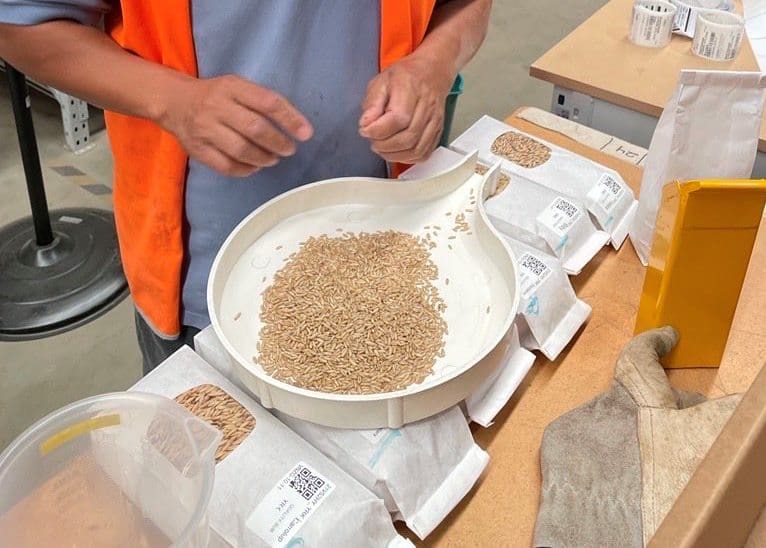
Food-product testing of oats in InterGrain’s lab. Photo: InterGrain
OPPORTUNITIES exist for Australia to increase its export of raw and processed oats for human consumption market, according to an insight from the Australian Export Grains Innovation Centre (AEGIC).
News on these opportunties was delivered as part of the Grains Research and Development Corporation Perth Update by AEGIC chief economist Professor Ross Kingwell said Australia’s the tonnage of Australian oats milled was already on the rise.
With human consumption of oats already increasing, further growth of 5 per cent annually over the next five years is forecast.
In line with this, so is Australia’s tonnage of oats milled annually, with the 2022 figure is expected to eclipse 300,000 tonnes, up from around 250,000t in 2020.
Prof Kingwell said recent gains in oat food-and-beverage consumption was expected to continue to help combat the increased global prevalence of “diseases of affluence”.
These include diabetes, obesity and heart disease, and have consumers seeking the health benefits of oats as an alternative to staples such as rice.
“The ability to include oats in traditional foods including noodles, or to mimic traditional foods such as rice, suggests ongoing value-adding opportunities for oats.”
Prof Kingwell said AEGIC has developed oat products and identified commercial partners to extend the local and international demand for oat-based food products, particularly those focusing on the emerging need for healthy grains in Asia and beyond.
China rising
Australia is already the fourth-largest global exporter of processed oats, and AEGIC research indicates there are “substantial opportunities” to grow this volume.
“Flaked oats continue to be Australia’s major oat export product, accounting for 80pc of oat product export sales.
“China is the fastest-growing oat market globally, and is rising in significance as a destination for Australian oats.”
In 2021 China was the main export destination for Australian oats, receiving almost 30pc of Australia’s oat product exports.
AEGIC has identified India has holding potential for processed Australian oats.
However, India’s tariff on imported processed oats is set at 30pc, which restricts its imports of processed oats from Australia.
“Lowering that tariff would provide Australia with greater access to what could become an export market.”
North American affair
Australia is regularly the second-largest global exporter of raw and processed oats combined, supplying about 10-15pc of world trade.
Canada supplies 75pc of world oat trade, and more than 80pc of its exports goes to the US.
“Moreover, oat production in the US and Canada is continuing to be constrained by very strong demand for competing rotational crops, especially soybean and canola.”
The US is the world’s largest importer of oats, followed by Germany and China, and Prof Kingwell said the health characteristics of oats frequently feature in food advertising in the US.
By illustration, General Mills is the US’s top cereal producer, and in the year to October 2021, its Honey Nut Cheerios remained the top-selling cereal in the US.
Honey Nut Cheerios includes oat as its main ingredient.
Husks off make shipping sense
Prof Kingwell said new oat varieties with improved milling specifications and higher yields will lift the gross margin attractiveness of oats and facilitate their rapid adoption by farmers.
Oat husks comprise 30-40pc of raw oat weight, and are sold domestically.
Noting the marked increase in shipping-container rates in 2021, Prof Kingwell said any improvements in milling specifications will help prevent the erosion of profit margins on containerised exports of processed oats.
“Containerised exports of processed oats have a 30-40pc weight-saving versus exporting containerised raw oats.”
Western Australia dominates national exports of oats, accounting for 80pc of total oat-product exports, followed by Victoria at 14pc and South Australia at 6pc.
“If Western Australian oat producers can more reliably deliver consistent exportable surpluses, then oat purchasers increasingly will look to Australia as a reliable supplier.”
The current five-year average for Australian oat production is around 1.4Mt, with around 1-1.1Mt used annually within Australia for seed, food and feed purposes.
Frost tolerance appeals
A particular attraction of oats is their greater frost tolerance, which greatly reduces revenue risk in frost-prone regions and in frost-prevalent parts of farm landscapes.
“Oats are approximately 2 degrees Celsius more frost tolerant than barley, which is 2 degrees more frost tolerant than wheat.”
However, Prof Kingwell said the main issue affecting growers’ commitment to oat production came from production volatility and resultant impact on oat pricing.
“The volatility in pricing affects farm-level returns but also affects Australia’s competitiveness in global markets for both raw and processed oats.”
“The challenge is to avoid under or oversupply of oats from Australia, which then exposes farmers to their oats being either priced out of certain markets, or being priced mostly for feed purposes.”
A five-year $11.5 million investment in oat breeding, announced in 2021, will help generate higher-yielding, market-orientated varieties drawn from a wider gene pool and thereby help underpin the commercial attractiveness of oats to growers.
In September 2021, AEGIC released a research report examining the strategic market outlook for oats AEGIC-Opportunities-and-risks-for-the-Australian-oat-industry-2021.pdf



HAVE YOUR SAY